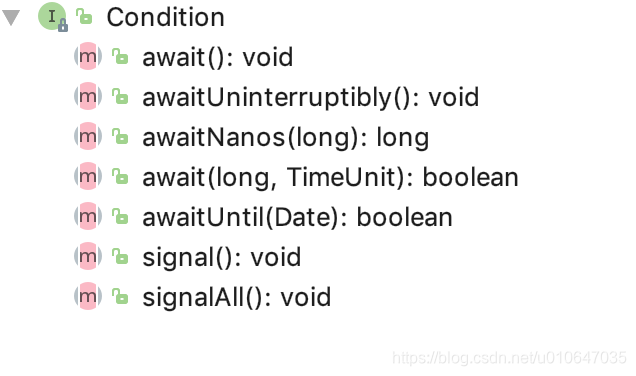1、概述
Condition 接口也提供了类似 Object 的监视器方法,它与 Lock 配合可以实现 等待/通知 模式,
当要实现一个等待/通知模式时,我们首先想到的就是 synchronized 同步关键字,它配合 Object 的 wait()、notify() 等系列方法实现。
还有一种实现方式,那就是使用显式锁 Lock ,配合 Condition 也可以实现等待/通知模式。
Object的监控器方法 和 Condition 接口,两者在使用方式及功能特性上还是有差别的,对比如下:
| 对比项 | Object 监视器 | Condition |
|---|---|---|
| 前置条件 | 获取对象锁 | Lock.lock() 获取锁,Lock.newCondition() 获取 Condition 对象 |
| 调用方式 | 直接调用,object.wait() | 直接调用,condition.await() |
| 等待队列数量 | 1个 | 多个 |
| 当前线程释放锁并进入等待状态 | 支持 | 支持 |
| 当前线程释放锁并进入等待状态,在等待状态中不响应中断 | 不支持 | 支持 |
| 当前线程释放锁并进入超时等待状态 | 支持 | 支持 |
| 当前线程释放锁并进入等待状态直到将来某个时间 | 不支持 | 支持 |
| 唤醒等待队列中的一个线程 | 支持 | 支持 |
| 唤醒等待队列中的所有线程 | 支持 | 支持 |
2、Condition 实现分析
Condition 定义了 等待/通知 两种类型的方法,当前线程调用这些方式之前,必须获取 Condition 对象相关联的锁。
Condition 是一个接口,
Condition 的实现类是 Lock(AQS)中的 ConditionObject。
Lock 接口中有个 newCondition() 方法,通过这个方法可以获得 Condition 对象(就是 ConditionObject)。
Condition 的使用方式比较简单,需要注意的是在调用方法前必须先获取锁:
Lock lock = new ReentrantLock();
Condition c1 = lock.newCondition();
Condition c2 = lock.newCondition();
lock.newCondition() 返回的是Condition的一个实现,该类在AbstractQueuedSynchronizer中被实现,该实现类为 ConditionObject
public class ConditionObject implements Condition, java.io.Serializable {
private transient Node firstWaiter;
private transient Node lastWaiter;
...
可以看到,等待队列和同步队列一样,使用的都是同步器 AQS 中的节点类 Node。
同样拥有首节点和尾节点,每个 Condition 对象都包含着一个 FIFO 队列。
2.1、Condition 接口方法说明
Condition 接口包含以下方法:

2.1.1、void await() throws InterruptedException:
当前线程进入等待状态直到被通知(signal)或者中断;
当前线程进入等待状态,直到被唤醒的场景有以下情况:
(1)其他线程调用相同 Condition 对象的 signal/signalAll 方法,当前线程被唤醒;
(2)其他线程调用 interrupt 方法中断了当前线程;
2.1.2、void awaitUninterruptibly()
当前线程进入等待状态直到被通知,在此过程中对中断信号不敏感,不支持中断当前线程,直到其它线程调用了相同 Condition 对象的 signal/signalAll 方法,当前线程才能被唤醒
2.1.3、long awaitNanos(long nanosTimeout) throws InterruptedException;
当前线程进入等待状态,直到被通知(signal/signalAll)、中断(interrupt)或者超时才会被唤醒
2.1.4、boolean await(long time, TimeUnit unit) throws InterruptedException;
当前线程进入等待状态,直到被通知(signal/signalAll)、中断(interrupt)或者过了指定时间才会被唤醒
2.1.5、boolean awaitUntil(Date deadline) throws InterruptedException;
当前线程进入等待状态,直到被通知、中断或者超时。如果没到指定时间被通知,则返回true,否则返回false
2.1.6、void signal();
唤醒一个等待在Condition上的线程,被唤醒的线程在方法返回前必须获得与Condition对象关联的锁
2.1.7、void signalAll();
唤醒所有等待在Condition上的线程,能够从await()等方法返回的线程必须先获得与Condition对象关联的锁
2.2、等待 await() 方法实现分析
public final void await() throws InterruptedException {
if (Thread.interrupted())
throw new InterruptedException();
Node node = addConditionWaiter();
//释放同步状态(锁)
long savedState = fullyRelease(node);
int interruptMode = 0;
//判断节点是否放入同步对列
while (!isOnSyncQueue(node)) {
//阻塞
LockSupport.park(this);
//如果已经中断了,则退出
if ((interruptMode = checkInterruptWhileWaiting(node)) != 0)
break;
}
if (acquireQueued(node, savedState) && interruptMode != THROW_IE)
interruptMode = REINTERRUPT;
if (node.nextWaiter != null) // clean up if cancelled
unlinkCancelledWaiters();
if (interruptMode != 0)
reportInterruptAfterWait(interruptMode);
}
分析上述方法的大概过程:
1、将当前线程创建为节点,加入等待队列;
2、释放锁,唤醒同步队列中的后继节点;
3、while循环判断节点是否放入同步队列:
-
没有放入,则阻塞,继续 while 循环(如果已经中断了,则退出)
-
已经放入,则退出 while 循环,执行后面的判断
4、退出 while 说明节点已经在同步队列中,调用 acquireQueued() 方法加入同步状态竞争。
5、竞争到锁后从 await() 方法返回,即退出该方法。
2.2.1、addConditionWaiter() 方法:
该方法是添加新的节点到等待队列并返回该节点
private Node addConditionWaiter() {
Node t = lastWaiter;
//清除条件队列中所有状态不为 CONDITION 的节点
if (t != null && t.waitStatus != Node.CONDITION) {
unlinkCancelledWaiters();
t = lastWaiter;
}
Node node = new Node(Thread.currentThread(), Node.CONDITION);
if (t == null)
firstWaiter = node;
else
t.nextWaiter = node;
lastWaiter = node;
return node;
}
同步队列的首节点移动到等待队列。加入尾节点之前会清除所有状态不为 Condition 的节点。
2.3、通知 signal() 方法实现分析
调用 Condition 的 signal() 方法,可以唤醒等待队列的首节点(等待时间最长),唤醒之前会将该节点移动到同步队列中。
public final void signal() {
//如果同步状态不是被当前线程独占,直接抛出异常。
if (!isHeldExclusively())
throw new IllegalMonitorStateException();
Node first = firstWaiter;
//通知等待队列队首的节点
if (first != null)
doSignal(first);
}
private void doSignal(Node first) {
do {
if ( (firstWaiter = first.nextWaiter) == null)
lastWaiter = null;
first.nextWaiter = null;
} while (!transferForSignal(first) &&
(first = firstWaiter) != null);
}
final boolean transferForSignal(Node node) {
//将节点状态变为0
if (!compareAndSetWaitStatus(node, Node.CONDITION, 0))
return false;
//将该节点加入同步队列
Node p = enq(node);
int ws = p.waitStatus;
//如果结点p的状态为cancel 或者修改waitStatus失败,则直接唤醒
if (ws > 0 || !compareAndSetWaitStatus(p, ws, Node.SIGNAL))
LockSupport.unpark(node.thread);
return true;
}
1、先判断当前线程是否获取了独占锁;
2、然后对首节点调用 doSignal() 方法,修改首节点
3、调用 transferForSignal() 方法将节点移动到同步队列
4、调用同步器的 enq 方法,将节点移动到同步队列
5、满足条件后使用 LockSupport 唤醒该线程
signalAll() 方法
将等待队列中的全部节点移动到同步队列中,并唤醒每个节点的线程
public final void signalAll() {
if (!isHeldExclusively())
throw new IllegalMonitorStateException();
Node first = firstWaiter;
if (first != null)
doSignalAll(first);
}
private void doSignalAll(Node first) {
lastWaiter = firstWaiter = null;
do {
Node next = first.nextWaiter;
first.nextWaiter = null;
transferForSignal(first);
first = next;
} while (first != null);
}
doSignalAll() 方法使用了 do-while 循环来唤醒每一个等待队列中的节点,直到 first 为 null 时,停止循环。
2.4、等待/通知 过程总结
1、一个线程获取锁后,通过调用 Condition 的 await() 方法,会将当前线程先加入到等待队列中,并释放锁。然后就在 await() 中的一个 while 循环中判断节点是否已经在同步队列,是则尝试获取锁,否则一直阻塞。
2、当线程调用 signal() 方法后,程序首先检查当前线程是否获取了锁,然后通过 doSignal(Node first) 方法将节点移动到同步队列,并唤醒节点中的线程。
3、被唤醒的线程,将从 await() 中的 while 循环中退出来,然后调用 acquireQueued() 方法竞争同步状态。竞争成功则退出 await() 方法,继续执行。
3、Condition 使用示例
下面通过一个有界队列的示例来了解 Condition 的使用方式。有界队列是一种特殊队列,当队列为空时,队列的获取操作将会阻塞获取的线程,直到队列中有新增加的元素;当队列满时,队列的插入操作将会阻塞插入的线程,直到队列有了可用空间。
package com.lkf.condition;
import java.util.Arrays;
import java.util.concurrent.locks.Condition;
import java.util.concurrent.locks.Lock;
import java.util.concurrent.locks.ReentrantLock;
/**
* 有界队列
*
* @author kaifeng
* @date 2019/1/1
*/
public class BoundedQueue {
//定义为数组,在创建对象时就确定容量
private Integer[] items;
private Lock lock = new ReentrantLock();
private Condition notEmpty = lock.newCondition();
private Condition notFull = lock.newCondition();
// 添加的下标,删除的下标和数组当前元素数量
private int addIndex, removeIndex, count;
public BoundedQueue(int size) {
items = new Integer[size];
}
/**
* 添加一个元素,如果数组满了,则添加线程进入等待状态
*
* @param object 添加的元素
*/
public void add(Integer object) throws InterruptedException {
lock.lock();
try {
while (count == items.length) {
notFull.await();
}
items[addIndex] = object;
if (++addIndex == items.length) {
addIndex = 0;
}
count++;
System.out.println(Thread.currentThread() + " 新增一个元素,当前数组为:" + Arrays.toString(items));
notEmpty.signal();
} finally {
lock.unlock();
}
}
/**
* 从头部删除一个元素,如果数组为空,则删除线程进入等待状态,直到有新元素添加
*/
@SuppressWarnings("unchecked")
public Integer remove() throws InterruptedException {
lock.lock();
try {
while (count == 0) {
notEmpty.await();
}
Integer temp = items[removeIndex];
items[removeIndex] = null;
System.out.println(Thread.currentThread() + " 读取一个元素,当前数组为:" + Arrays.toString(items));
if (++removeIndex == items.length) {
removeIndex = 0;
}
count--;
notFull.signal();
return temp;
} finally {
lock.unlock();
}
}
}
有界队列测试客户端:
package com.lkf.condition;
import java.util.Random;
import java.util.function.Consumer;
/**
* 有界队列测试
*
* @author kaifeng
* @date 2019/1/1
*/
public class ConditionDemo {
private final static Random random = new Random();
public static void main(String[] args) {
BoundedQueue queue = new BoundedQueue(5);
for (int i = 0; i < 5; i++) {
Thread thread = new Thread(new ProducterRunable(queue), "ProdducterThread_".concat(String.valueOf(i)));
thread.start();
}
for (int i = 0; i < 5; i++) {
Thread thread = new Thread(new ConsumerRunable(queue), "ConsumerThread_".concat(String.valueOf(i)));
thread.start();
}
}
/**
* 插入元素到队列
*/
static class ProducterRunable implements Runnable {
private BoundedQueue queue;
public ProducterRunable(BoundedQueue queue) {
this.queue = queue;
}
public void produce() throws InterruptedException {
queue.add(new Integer(random.nextInt(100)));
}
@Override
public void run() {
try {
produce();
} catch (InterruptedException e) {
e.printStackTrace();
}
}
}
/**
* 从队列读取元素
*/
static class ConsumerRunable implements Runnable {
private BoundedQueue queue;
public ConsumerRunable(BoundedQueue queue) {
this.queue = queue;
}
public Integer remove() throws InterruptedException {
return queue.remove();
}
@Override
public void run() {
try {
remove();
} catch (InterruptedException e) {
e.printStackTrace();
}
}
}
}
测试结果如下:
Thread[ProdducterThread_0,5,main] 新增一个元素,当前数组为:[91, null, null, null, null]
Thread[ProdducterThread_2,5,main] 新增一个元素,当前数组为:[91, 79, null, null, null]
Thread[ProdducterThread_1,5,main] 新增一个元素,当前数组为:[91, 79, 24, null, null]
Thread[ProdducterThread_3,5,main] 新增一个元素,当前数组为:[91, 79, 24, 30, null]
Thread[ProdducterThread_4,5,main] 新增一个元素,当前数组为:[91, 79, 24, 30, 70]
Thread[ConsumerThread_0,5,main] 读取一个元素,当前数组为:[null, 79, 24, 30, 70]
Thread[ConsumerThread_1,5,main] 读取一个元素,当前数组为:[null, null, 24, 30, 70]
Thread[ConsumerThread_2,5,main] 读取一个元素,当前数组为:[null, null, null, 30, 70]
Thread[ConsumerThread_3,5,main] 读取一个元素,当前数组为:[null, null, null, null, 70]
Thread[ConsumerThread_4,5,main] 读取一个元素,当前数组为:[null, null, null, null, null]